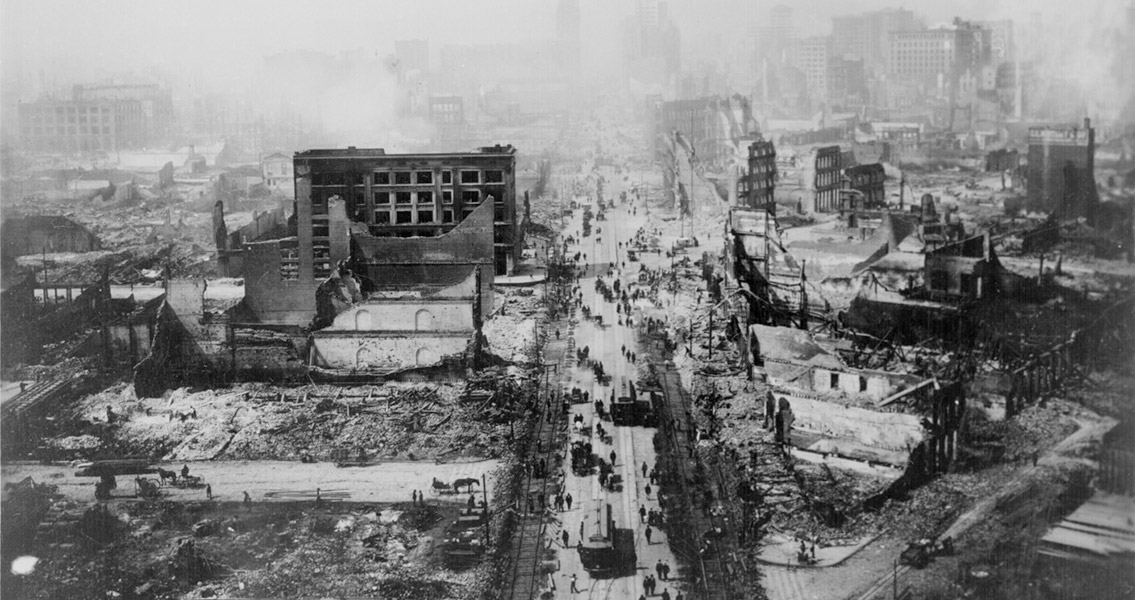<![CDATA[At 5:12 am on the morning of 18th April 1906, the first foreshock of the Great San Francisco Earthquake was felt around the Golden City. The powerful precursor shook most of the Bay area, stirring the city's inhabitants, but it was nothing compared to what immediately followed. Around 25 seconds later the main earthquake struck. The 7.8 magnitude tremor had its epicentre close to San Francisco's downtown, but it was felt in Oregon to the north, Los Angeles to the south, and as far inland as Central Nevada. Lasting no more than a minute, the effect of the earthquake permanently scarred San Francisco, flattening huge swathes of the city. Beyond the devastation it wrought however, the earthquake has since played a crucial role in allowing scientists to improve their understanding of seismic events. The cause of the Great San Francisco Earthquake was a slip of a 296 mile long segment of the San Andreas fault, from San Juan Bautista to the triple junction at Cape Mendocino. The horizontal displacements of the slip confounded geologists at the time, and it wasn't until the advent of the science of plate tectonics almost half a century later that scientists would start to fully understand the cumulative effect of the fault movement in the quake. Nevertheless, by analysing the ground displacement caused by the earthquake, seismologist Henry Fielding Reid formulated his elastic rebound theory, which to this day is the principal model to explain the earthquake cycle. San Francisco was enjoying a period of rapid growth and development during the first years of the twentieth century. The city's perfect climate and vibrant cultural scene was attracting people from across the USA, while the thriving economy there had seen high rise buildings starting to dominate the skyline. The tremors on the 18th April however, left the city almost unrecognisable. Hundreds of buildings were toppled in the earthquake. Although steel framed structures withstood the tremors remarkably well, they were a minority in the city, most of San Francisco having been built with wood or brick. Water and gas pipes under the city's streets were torn open, while telegraph and telephone lines fell down, starting a communications black out in some parts of the city. The business district was one of the most seriously hit, the area almost totally flattened. The worst however, was yet to come. One consequence of the earthquake was the chimneys on many buildings had collapsed, a seemingly trivial fact which would go on to have tragic consequences. "It was only then that I began to realize the extent of the disaster which had befallen the city. The fire had started simultaneously in many different places when the housewives had attempted to get breakfast for their families, not realizing what a menace the ruined chimneys were. All along the skyline as far as eye could see, clouds of smoke and flames were bursting forth." recalled Arnold Genthe, an eye witness to the earthquake. As the city erupted in flames, a combination of the damaged chimneys and several arsonists burning their own property in the hope of gaining insurance payouts, order was completely lost on the streets of San Francisco. Looting broke out, which the city mayor responded to by announcing any looters would be shot on sight. The fire brigade could not gain access to water as a result of the burst water mains, leaving them with no choice but to demolish certain buildings to create 'fire breaks'. The city's fire chief was mortally wounded in the earthquake, leaving the fire department leaderless and uncoordinated. Martial law was declared, while firefighting efforts continued for several days, aided by National Guard soldiers who had been called in to restore order. By April 23rd order had been restored, and the devastating extent of the earthquake became apparent. 3,000 lives had been lost over the five days, and over 25,000 buildings destroyed. 250,000 people, more than half of the city's 400,000 strong population, were left homeless. In just a few days one of the USA's most distinct and vibrant cities had been devastated beyond recognition. ]]>
1906 San Francisco Earthquake Leaves Half the City Homeless
